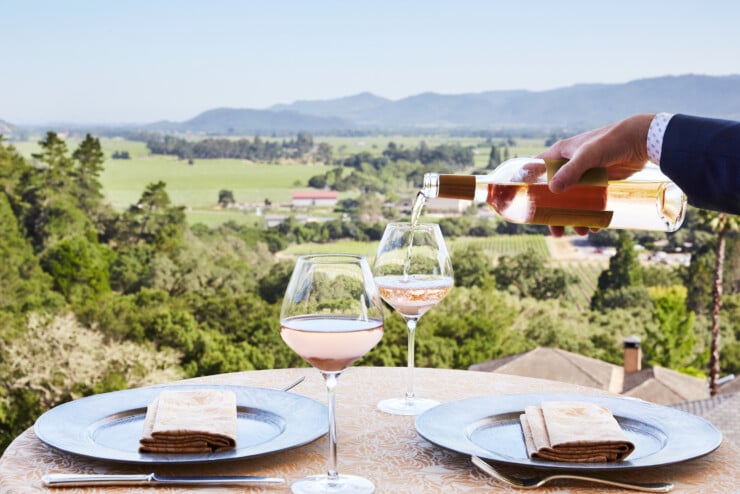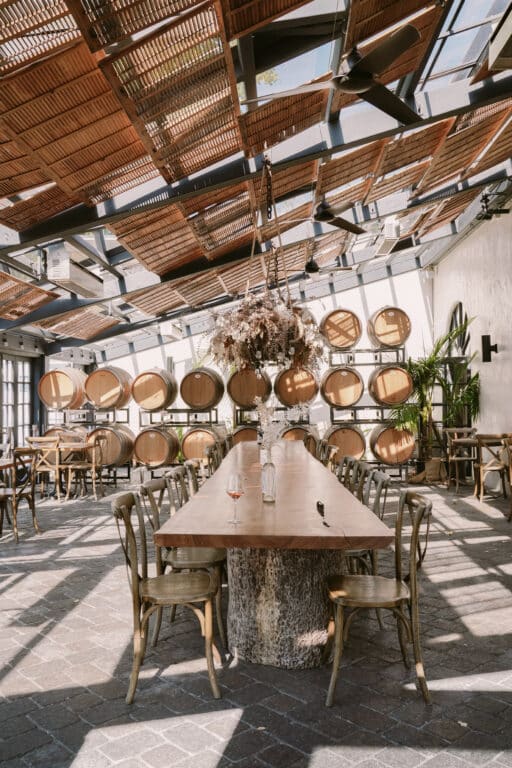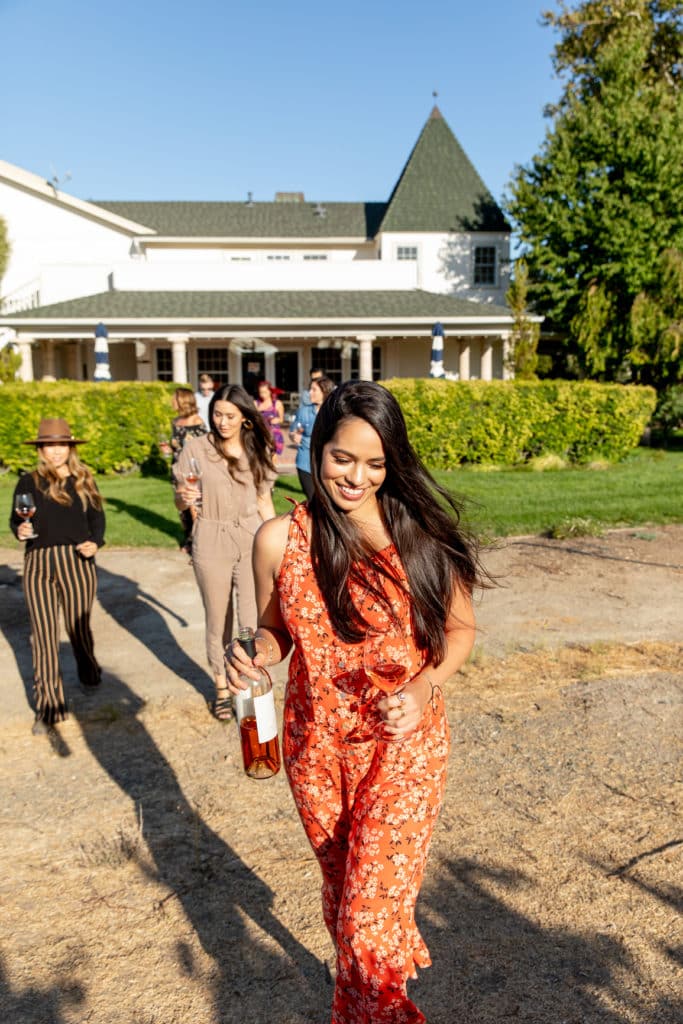Did you know 81% of the wine produced in the United States is from California? Translation: wine lovers should sip a lot when they visit, from the paradigm-shifting sustainable wines to the sought-after cult bottles.
For any wine enthusiast, planning a vacation to the California wine regions is a dream, but deciding where to visit can be anxiety-inducing. Head to the world-famous Napa Valley? Or go a deeper cut and visit Lodi?

10 California Wine Regions To Visit
Across the state, you can visit modern tasting rooms and converted barns alike. Here are ten California wine regions to consider for your next wine-focused trip.
Napa Valley: For World-Famous Wines
When you think of California wine regions, Napa Valley is probably the first that comes to mind.
This thirty-mile-long valley is home to 240 wineries, Michelin-starred chefs, and replica Tuscan castles. And, just about one hour north of San Francisco, Napa County is a classic choice for a California wine excursion.
Although Napa is world-famous as a California wine region, it actually only produces 4% of the wine in California.
Sonoma County: For Farm-To-Table Heaven
There are more than 500 wineries in Sonoma growing more than 50 varieties of grapes. And, though the region grows more Pinot Noir than any other area in California, there’s more than just this noble grape.
Because of the varied landscape that spans from coastal cliffs to rolling green hills, there are many numerous microclimates in Sonoma. Some of the vines you can find planted here include Cabernet Sauvignon, Chardonnay, Merlot, Zinfandel, and Sauvignon Blanc.
The best-known AVAs worth visiting in Sonoma include the Russian River Valley, Dry Creek, Alexander Valley, Knights Valley, and Chalk Hill.
And be sure to spend time shopping, trying the local food, exploring the Sonoma cheese trail, and wandering the towns of Healdsburg and Sonoma.
Carneros District: For Crisp, Cool-Climate Wines
Can’t decide between Napa Valley and Sonoma County? Get the best of both worlds and head to Los Carneros.
Sitting at the southern ends of both of these world-class wine regions, Los Carneros is one of the California wine regions known for its cool and often foggy coastal microclimate, which makes for crisp Chardonnay as well as sophisticated Merlot, Pinot Noir, and Syrah.
It’s also where some of the state’s top sparkling wine producers like Gloria Ferrer, Domaine Carneros, and Chandon as well as high-end Pinot producers like Ram’s Gate are located.

Santa Cruz Mountains: Vistas And Vines
If you are looking for a California wine region that is as geographically dramatic as the wine is delicious, consider visiting the Santa Cruz mountains.
Tucked amongst winding mountain roads and impressive redwoods, you’ll find vineyards producing distinctive, Old World wines in an incredible setting.
One of our favorite wineries in the area is Bonny Doon whose French-inspired wines like their Vin Gris and their Picpoul pair fabulously with the regional farm-to-table fare and local seafood.
Monterey: Vines, Pebbles, and Pines
Are you the type of person who likes to explore the lesser known?
If so, check out Monterey, which, to us, is one of the most underrated of all the California wine regions. Understandable since it’s better known for being the “salad bowl of the country” seeing leaf lettuce is the majority of what is grown in Monterey.
Monterey winemaking didn’t become a thing until the late 1950s when the Santa Clara and Livermore Valleys were becoming more urbanized. Around the same time, UC Davis released research that fine wines could be produced in cooler, coastal climates, and that led to the birth of Monterey County winemaking.
Some of the notable vineyard regions in the Monterey area include Carmel Valley, Arroyo Seco, the Santa Lucia Highlands, and Chalone. Be sure to check out the prized creations of producers such as Caraccioli, Talbott, and Scheid.
Paso Robles: For Red Rhone Lovers
Fun fact? The cultivation of grapevines in San Luis Obispo County dates way back to the presence of Spanish missionaries.
With more humid, cooler conditions than many other California wine regions, Paso Robles has similar geology to France’s Rhone Valley. While you’re here, you can try southern Rhone-style wines as Bordeaux blends.
On your trip to Paso Robles, you’ll be charmed by rolling hills and valleys that are protected from marine fog and coastal winds. And it’s a haven for red wine drinks because 80% of the wines produced in Paso Robles are reds, including the aforementioned Rhone varietals and Cabernet Sauvignon and Zinfandel.
Santa Barbara: For Laidback Luxe Wines
If you’re looking for a truly memorable trip, head to Santa Barbara County. A charming Californian landscape (which is really saying something!), the unusual geography of this region has led to one of the best California wine regions.
You can explore this region’s wine both in and out of the city limits. With an urban wine trail known as the Funk Zone and gorgeous wine-growing centers outside of the city limits, you’ll have plenty of ideas for filling up your itinerary. Also, be sure to try the wine with some of the incredible locally-grown food at one of the many weekly Santa Barbara farmers’ markets.
Los Angeles: Wineries Near Hollywood
When you think of Los Angeles county, vineyards might not be the first thing that comes to mind. However, there are actually more than 50 vineyards in the region of coastal Malibu.
Here you can follow the Malibu Wine Trail or take a guided tour to explore Malibu, Rodeo Drive, and Santa Monica’s famous pier.
Mendocino: Sip Amongst The Redwoods
Within the North Coast region, Mendocino County is the northernmost wine-growing area. Cool, foggy, and blanketed in forests of redwoods, you can find an abundance of Pinot Noir, Cabernet Sauvignon, and Chardonnay here.
However, there are also dozens of other varietals grown here due to the diverse climate and geography of the county.
As outdoor lovers, this is one of our favorite places to road trip in California and the numerous quality wineries are just the cherry on top.
Sierra Foothills: For Gold Country Vibes
Home to California’s Gold Country and some of the richest history in the state, you can explore quaint gold mining towns with old vines, delicious wines, and gorgeous rolling hills.
Set along the western edge of the Sierra Nevada foothills, this AVA starts at Yuba, Placer, and El Dorado counties in the north and ends in Mariposa County in the south.
Most travelers visit this part of the state to venture into Yosemite National Park or east to Lake Tahoe but it’s also very much worth it to make time for some wine tasting too. You can find top-quality Zinfandel in Amador County as well as Sangiovese and Barbera.
Frequently Asked Questions
California wine history started in 1769 at Mission Basilica San Diego de Alcalá. Franciscan Father Junipero Serra was heading up the mission founding (a trail that eventually ran 600 miles north to Sonoma!) and each was planted with vines of the wine grape we now call the Mission grape.
But the California commercial wine industry didn't get its start until 1834 when Jean-Louis Vignes planted vineyards near modern-day Los Angeles.
After the gold rush in 1849, the industry took off and by 1919 the state had more than 1,000 wineries. Prohibition meant wineries took a hit but with the legendary "Judgement Of Paris" California wine garnered worldwide recognition.
Like all US wine regions, the state of California is organized by federally-recognized growing regions, called American Viticultural Areas (AVAs).
The entire state of California and each of its counties are considered a wine region and are known as an appellation of origin.
From there California has four very large regions (technically AVAs) that overlap many smaller AVAs and they are North Coast, Sierra Foothills, Central Coast, and South Coast. In other words, the North Coast includes Mendocino, Russsian River Valley, Sonoma Valley, and Napa Valley.
The AVAs that don't fit into the four larger ones above are grouped using the unofficial terms Far North, Inland Valley, and Southern.
As of 2022, California has 147 total AVAs. Since we're on the subject, let's clarify a few things about labeling:
- AVA: To list an AVA on a wine label, at least 85% of the grapes had to have been grown in that AVA
- County Names: To put a county name on a label, that number is 75%.
- California: Wine labeled “California” (or with any California AVA) requires that 100% of the grapes grew in the Golden State
While all those terms above are regulated, the term "wine country" is not. As Californians, we say "wine country" whenever we're heading to one of the corners of the state – be it Santa Cruz, Sonoma, Paso Robles, or Temecula – where the focus is on winemaking.
But, when most people refer to "wine country," they're largely referring to the area north of San Francisco where the three world-renowned California wine regions of Sonoma Valley, Napa Valley, and the Russian River Valley are located.
From the misty northern coast to the arid southern foothills, you'll find more than 100 varieties of grapes grown in the Golden State.
But the vast majority of the California wine regions are dedicated to growing just eight wine grapes, specifically: Cabernet Sauvignon, Chardonnay, Merlot, Pinot Noir, Pinot Gris, Sauvignon Blanc, and Zinfandel.
The largely arid, sunny, and mild climate of California is similar to the Mediterranean which makes it ideal for full-bodied red wines.
But regions along the ocean, like Mendocino, Sonoma, and Santa Barbara, receive fog which is called "refrigerated sunshine" around here! Those areas have great success with cooler climate varieties including Pinot Noir.

Plan a Trip to California Wine Country
While it’s easy to dream of a land of grapevine-covered hills, sunshine, and endless wineries, there are definitely some logistical considerations to take into account, too.
Planning Winery Tastings
Almost every winery is going to have different policies when it comes to reservations. In the more popular wine regions like Napa, Sonoma, and Paso Robles, the majority of the wineries have started requiring reservations in advance so definitely have a plan.
Even so, other wineries do allow walk-ins. There are typical tours at several different times throughout the day at wineries.
You’ll want to think about which wineries you want to tour versus those you just want to enjoy a tasting to make the most of it.
We suggest you don’t schedule more than two or three tastings a day so that you aren’t rushed and you can leave time for exploration.
How To Drive In Wine Country
Planning a road trip through California wine country? If so, check out these essential tips for a California road trip.
And it’s best to have a designated driver for each day you’ll be wine tasting. If you prefer to hire a driver, go ahead and reach out to us and we’ll help you arrange that.
California Road Trip Planner
Did you know we’re also a boutique travel agency that specializes in California vacation planning? If you’re looking to plan a trip to California, our California trip planner services are here to help you plan your perfect itinerary.
Photo Credit: Photos by Jayme Burrows, Jesse Murrow, and Trinette Reed
Sponsored Content: This post was brought to you by California Grown and Discover California Wines, but all content, ideas, and words are our own. Thanks for supporting these sponsors who allow us to keep Salt & Wind Travel up and running.